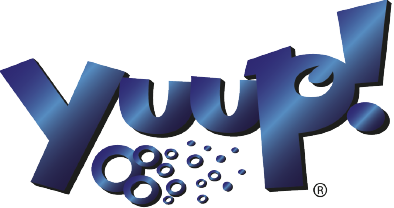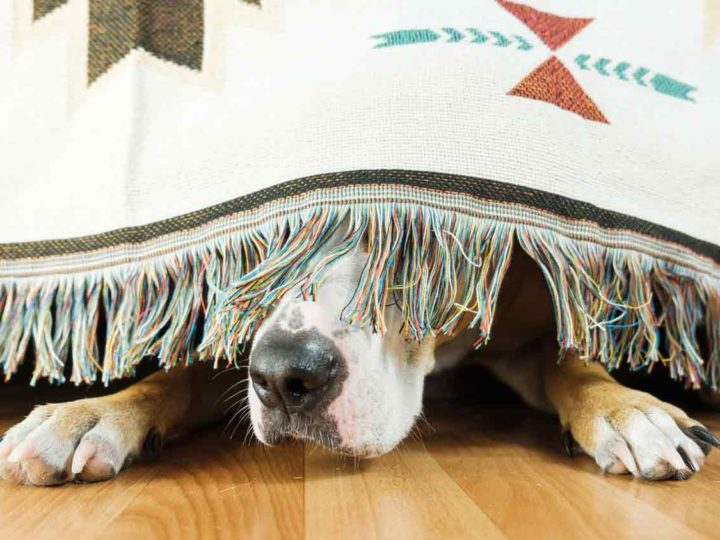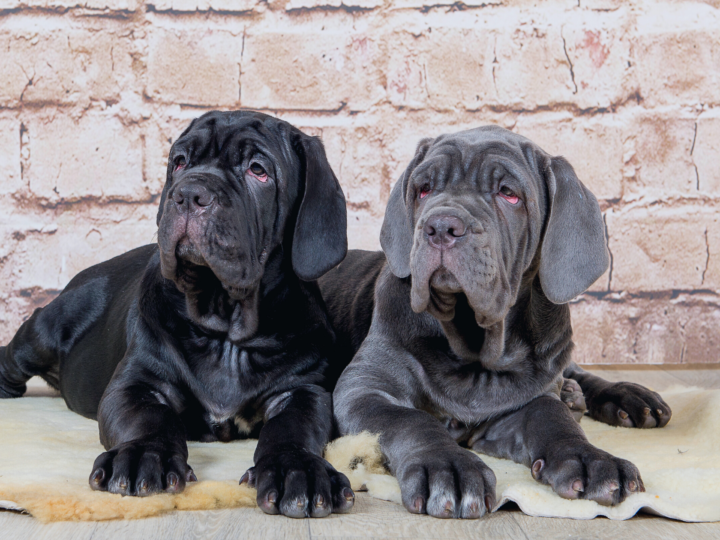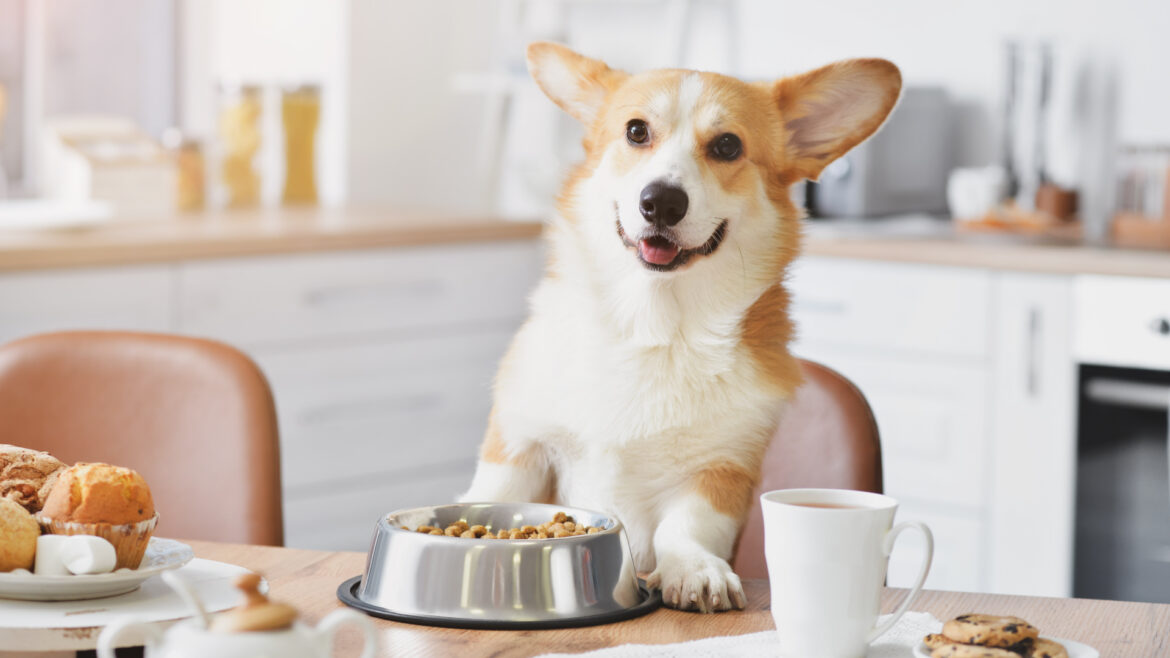
Dogs, known for their loyalty and fondness, can face various challenges in the family context, especially during mealtimes at the table. In this article, we will focus on how to teach our four-legged friends to behave correctly while we are at the table, avoiding unwanted and inappropriate attitudes. We will also talk about the importance of correct nutrition, which is fundamental for the dog’s health and well-being.
Dog table manners
Sitting at the table for the daily meal is a fundamental moment of our days, and although we deeply love our dog, sometimes we would like to have a bit of calm around us to be able to peacefully eat and enjoy our dishes at the table. Inevitably, even if our movements are silent and agile, at that very moment… two little eyes emerge from under the table (do our dogs have a radar?) and look at us lovingly, to have some of our food! Does it happen to you as well?
But what to do while you are sitting at the table? How to act to avoid the insistent requests of our dogs to get a portion of our dish?
The key to good dog behavior during mealtime begins with the definition of clear rules, to be respected from the beginning. It is essential that our dog understands the boundaries and the spaces of this moment. A coherent and patient approach is essential for the correct education of our furry friend at the table.
So how can we teach our dog the correct behavior at the table while we are eating? Here are our suggestions:
-
Talking to family members and intervening coherently: starting from the assumption that there is no general rule regarding the correct behavior of the dog while we are at the table, it is important to talk to family members and discuss how to behave in regard to the dog. Giving table food to the dog is not a real mistake but a real problem can arise when his behavior becomes repeated, obsessive and annoying. It is therefore essential that, when we choose to adopt a specific behavior at the table, all family members have to act in the same way, so that the dog knows what to expect while we are sitting at the table. The more you are able to be consistent, the more you will allow the dog to know the response to his request while at the table and the quicker the results will be obtained.
-
Excluding nutritional deficiencies: check that dog request for table food is not caused by an unbalanced diet or hunger. To exclude any doubts, we suggest you considering a visit to your trusted vet or to a vet doctor expert in nutrition.
-
Do not yield to temptation: it often occurs that dogs want to get a piece of food while we’re eating at the table just for… greed! In fact, excluding the hypothesis of a food deficiency, his sweet requests may not be caused by hunger, but by the pleasure of trying what we are eating at the table. Our recommendation is to serve our four-legged friend’s meal before or during our mealtime, so that he will satiate by himself without disturbing us.
-
Ignoring his insistence at the table: if the dog insists during our mealtime, first by crying, then with his paw or even by putting his nose under our arm or between our legs, the behavior to adopt is ignoring his conduct while sitting at the table. In this way we will discourage his requests during this precise moment without taking him into account. If the dog uses this behavior at the table, it is precisely because he knows he can get something. Perhaps when he was a puppy, we have naively satisfied his requests during a meal and, once the dog has discovered that this strategy works, then he will try to propose it again, perhaps even in a more marked way. The dog is an animal who loves the routine and it can be said that sometimes he learns thanks to experience, so in this case our position is crucial in the adoption of a behavior. We decide which behaviors deserve to be rewarded and vice versa those to be ignored, especially when we are sitting at the table.
-
Proposing an alternative: if our dog is used to quickly sprint towards the table when it’s time for meal and we want to help him change this habit, an alternative given at the right time can come to our rescue. A solution could be to provide our furry friend with a chew or a toy to keep him busy for the necessary time of our stay at the table, but we must be careful to give the object before sitting down at the table. If we give it while we are already at the table, our dog can interpret it as a reward, thus reinforcing that behavior we do not appreciate during mealtime.
-
Verbal association: in order to stop incorrect manners at the table you can say a word, already used in other situations and therefore clear and already known by our furry friend, such as a simple “NO”. In this case, however, we would create a verbal association making him understand how he should not behave in that situation, but not what he should do as an alternative. So it’s important to understand that a “NO” may stop the behavior at that moment, but it won’t stop the dog from repeating it in the future. This is why it is essential to also evaluate what we previously said and to understand, for example, how to teach the dog not to get on the table.
-
Doing activities before meal: our dogs, especially if they’re still puppies, have a certain amount of both physical and mental energy and the expenditure of mental energy is faster than the physical one. For our furry friends, engaging mentally in solving a “problem”, which for them become a mental game, could be good so as to lead them to discharge their energy and get tired to the point of not paying attention when we sit down at the table for the meal. With targeted activities, such as mental activation games, everyone will be satisfied: we can peacefully eat at the table and he, tired and pleased, will enjoy the well-deserved rest, after training his intelligence. Remember to use a game of the correct difficulty level for your dog, and if necessary gradually increase the complexity, in this way there will always be some mental work to “solve” and this will guarantee him a greater expenditure of energy which means relaxing time for you at the table.
-
A healthy walk together: why not? A nice walk with your furry friend, through a path full of different stimuli and smells, could really get him tired, both physically and mentally, to the point of collapsing satisfied into his doghouse as soon as you return home… but make sure you already have your lunch ready, because energy recharges quickly! Furthermore, in this way we will also encourage a correct routine regarding activity times and meals. In fact, for dogs it is important that physical activity is done before meals, to minimize the risk of problems such as stomach torsion, since dogs are more subject to it after eating, due to the stomach dilation assignable to the food presence.
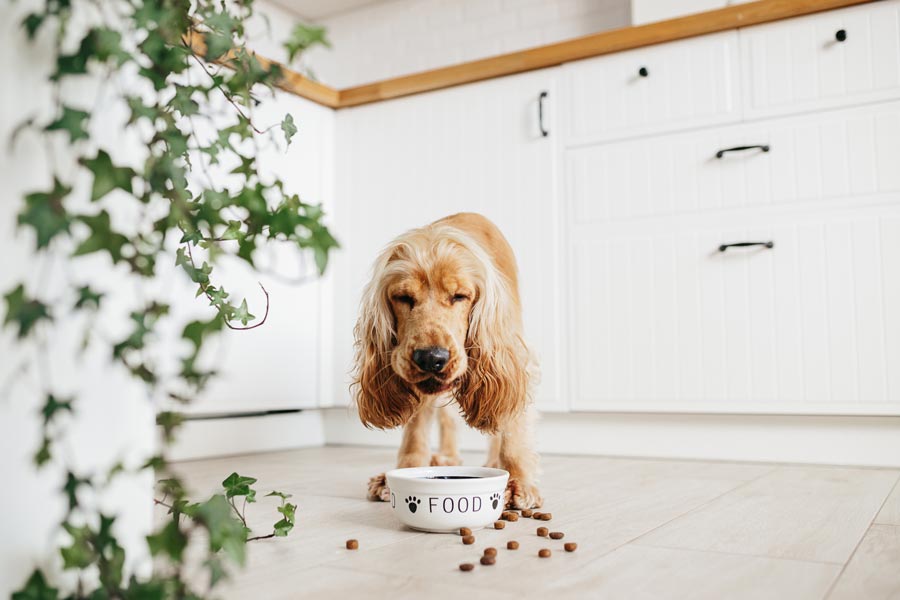
The secret to a peaceful meal: each one needs his own dishes and spaces.
Managing dog nutrition
In addition to good table manners, it is important to remember that in general dog nutrition is an absolutely fundamental aspect for his health. One of the most widespread questions is: which are the most suitable “human” or not foods for their diet? The answer? It depends!
Well yes. Just like us humans, the diet can depend on the dog’s state of well-being, current pathologies or other important aspects of his health. Our recommendation is to contact a vet or a vet doctor expert in nutrition, to rely on their advice and define the best diet for our Fido.
For example: would you like to know if your four-legged heart can follow a vegan diet? We talked about it in this article.
In general, in addition to particular conditions and specific diets that our dog may have to follow, it is possible to define a series of foods that are good for his health, as well as a list of foods that are absolutely contraindicated and to be avoided since they are unhealthy or toxic for them.
Let’s discover them together.
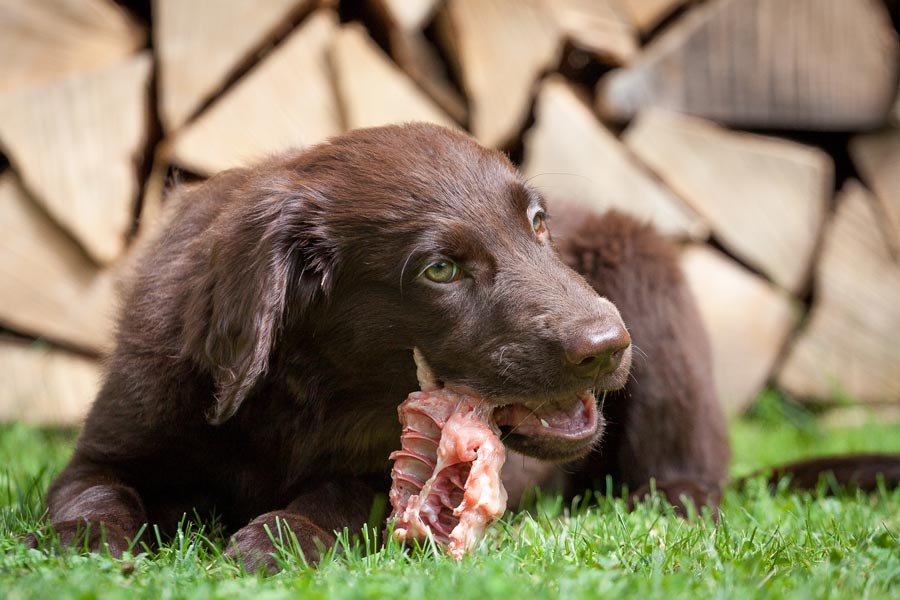
Nutrition is an essential element for the health of dogs.
Safe foods for dogs
Can the dog eat every fruit we have at home? Or are there certain types to avoid?
- Fruits can be rich in properties but also in sugars. It is therefore good to evaluate not only which fruit to give but also the doses to avoid exceeding.
- Banana: since it is high in calories it would be better to provide small quantities, potassium and mineral salts are excellent for the intestine. In general, our furry friends really like it, perhaps for the consistency or the for taste, it is always devoured very quickly from the bowl!
- Apple: it contains vitamin C which is good for digestion and provides calcium and fibers to the organism. The idiom “an apple a day keeps the doctor away” would be better not to be taken into consideration for our puppies, in fact, although it is excellent for the intestine and for cleaning the teeth, unfortunately it contains several sugars!
- Tangerine: it’s rich in vitamin C. But make sure you peel it well and remove all the seeds.
- Strawberry: among the best natural antioxidants, with vitamins C and B9, excellent for the health of his skin. To be consumed moderately. It offers diuretic and digestive properties. However, we need to be careful to the first intake, as strawberries are a fruit with a high allergenic potential and it is best to avoid them if our dog is very sensitive or has an allergic constitution.
- Cherry: they definitely go crazy for them! Remember to remove the pit before providing to avoid the risk of poisoning, suffocation or intestinal obstructions. Be thrifty with quantities, as among their benefits there is the laxative effect which could lead to diarrhea.
- Pear: this fruit has many benefits, it is composed of 80% water, but it is also rich in vitamins, potassium and copper. However, the pear also has a lot of sugars, especially fructose, so it is important not to exceed with the quantities.
What about the fruits to avoid?
Of course, there are some types of fruit that can have negative effects on dogs and should therefore be avoided. Only the pulp of avocado is allowed to dogs, in fact the seed and the peel contain Persin, a toxic substance. Grapes and raisins cause damage to kidneys and liver. Dried fruit is also very dangerous, especially Macadamia nuts which are extremely toxic.
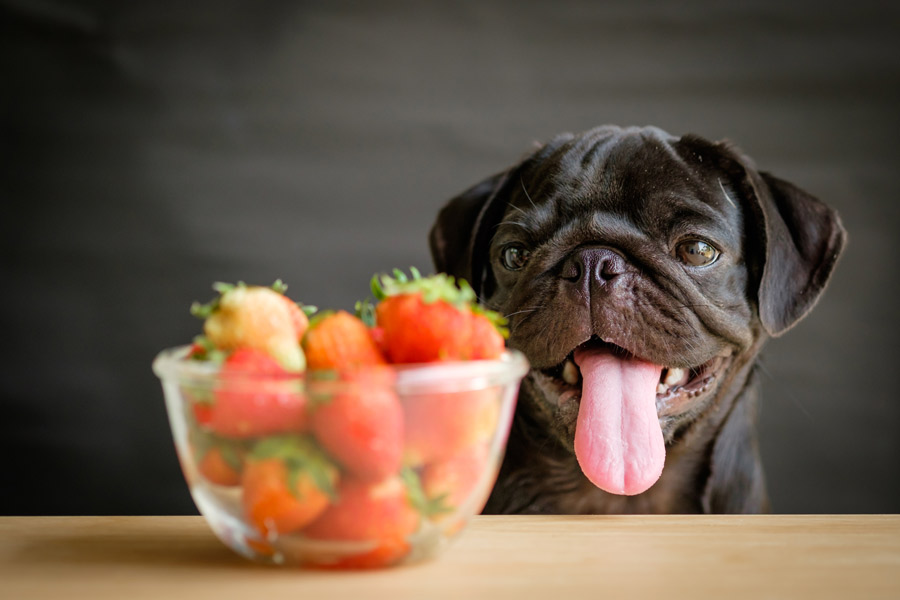
Some types of fruit are good for our dogs as well. As always, however, there are some rules to be followed like beware of diets and allergies.
And what vegetables can our dog eat?
We know that dogs are omnivores, it means that they can eat both animal and plant-based ingredients. Vegetables can have many benefits for their health, but it is in any case preferable to supply them raw both for problems connected to ingestion and for maintaining their properties. Talking about it with your vet will allow you to better understand how to integrate this food on a daily basis, because it could vary based on the age, energy and breed of the dog. Vegetables are a source of vitamins and proteins, both for us and for our four-legged hearts.
Let’s find out together which vegetables we can share with them:
- Peas: legumes, rich in vitamins and in antioxidant properties, are present in many types of kibble. However, they are also rich in fiber, so be careful not to exceed with quantities.
- Pumpkin: very tasty even for our pets, also present in many kibbles on the market, this vegetable is not only rich in fiber but also guarantees excellent diuretic and antioxidant properties.
- Salad: it is certainly purifying for our furry friends, remember to wash it and cut it into small pieces, as improper chewing could cause asphyxiation.
- Spinach: excellent choice as it has great vitamin properties (A, B, C, E and F). It is advisable not to cook them to avoid problems with sticking to the palate.
- Green beans: mineral salts and vitamins A and C guarantee an excellent energy supply. It is advisable to cut them into small pieces.
- Carrot: a good idea for a healthy snack, as chewing helps eliminate plaque and tartar.
- Fennel: contains vitamins A, C and K, and minerals such as calcium, potassium and iron.
- Celery: recognized as a safe and healthy food for dogs, it contains carbohydrates, fats, proteins and water, vitamins and minerals, which provide energy.
What about the vegetables to avoid?
Some types of vegetables (or plants similar to vegetables) are unfortunately toxic to our furry friends, such as onion, garlic and leek as they contain dangerous substances such as N-propyl disulphide and allicin. Giving these vegetables to our dog, even if in small quantities can be very, very dangerous, they can put in danger the life of our 4-legged hearts, regardless they are fresh or cooked. Potatoes, on the other hand, should be given to the dog exclusively cooked, since raw potatoes contain solanine, a toxic alkaloid, which is inactivated precisely through cooking.
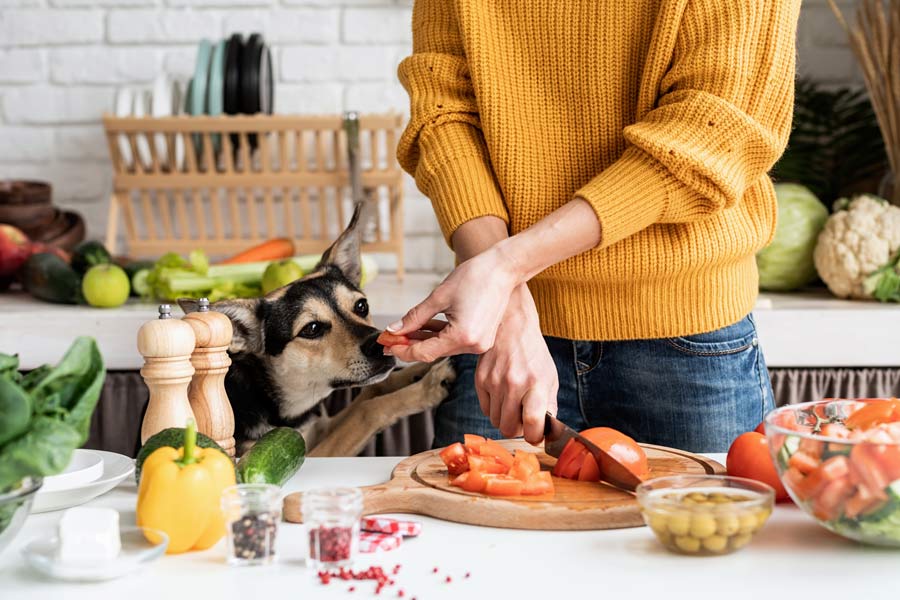
Vegetables are good for our dogs: healthy, fresh and nutritious.
Adding these foods into your dog’s diet can bring significant benefits. It is important, however, to introduce new foods gradually and beware of any allergic reactions or digestive problems. Furthermore, these foods should be considered as a complement and not as the main source of nutrition.
Even chocolate, cookies, cakes and other sweets are not recommended at all: as it happens with us humans, sugar consumption leads to glycemic imbalances in blood, affecting the regular metabolic actions of the organism and in some cases even leading to diabetes. Chocolate is really dangerous: it contains two methylxanthine alkaloids, theobromine and caffeine, which combined are extremely toxic for the digestive system, for the kidneys, for the heart but also for the nervous system of dogs and cats which metabolize some substances in a very different way than us humans.
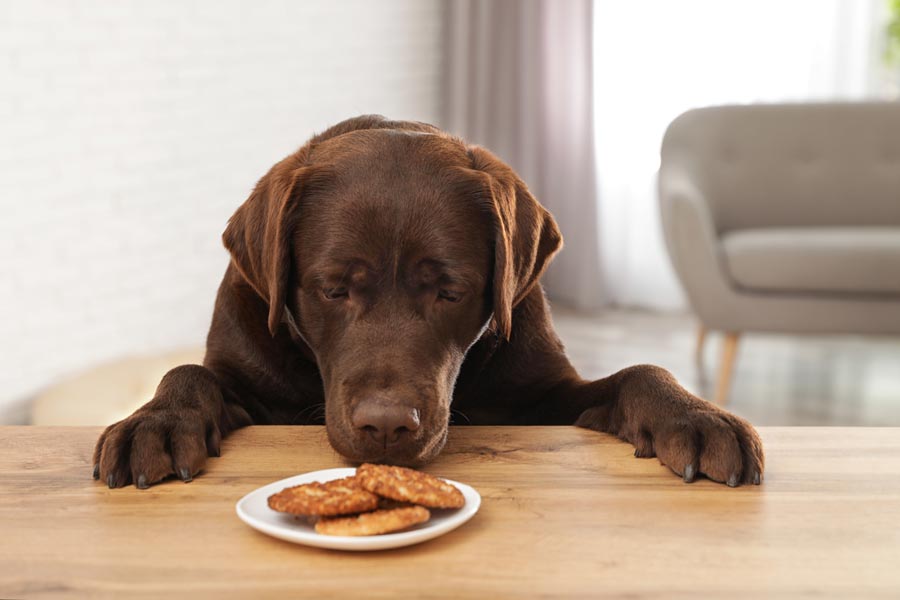
Among forbidden foods for dogs sweets are one of the first to mention.
Carbohydrates are also a food that we should not give to our dogs. Pizza and pasta above all, these foods are made up of complex sugars that our furry friends cannot digest well. This is because, as already mentioned, their gastrointestinal system is not as developed as ours and is not suitable for absorbing this type of food.
The ideal number of meals per day for a dog
We have seen what foods we can share with our beloved dogs. But during a day, which is the recommended number of meals for them?
Again, the response is: it depends.
A large-sized dog may need to eat up to three times a day, while a small dog may be satisfied with just one meal. On average, the recommended frequency of meals is two per day, but let’s remember to always rely on professionals who will be able to indicate the exact number of meals suitable for our puppy.
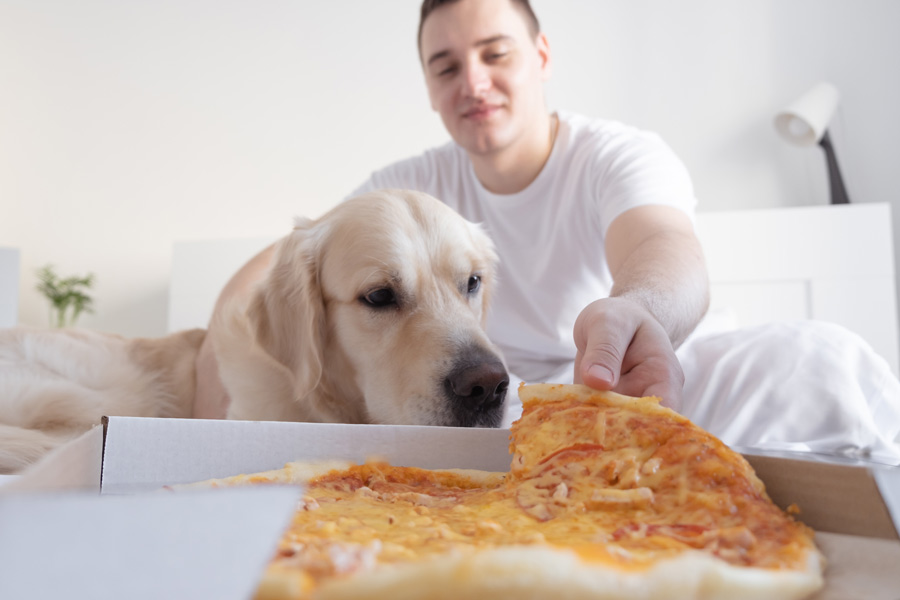
We know you would like a slice, but pizza isn’t good for you dear Fido. Moreover, you’ve already eaten twice today!
We have seen that meals at the table are a moment in which our dog can behave wrongly and we have discovered the remedy. We have found out which among the foods we eat can be given to our dogs and which are those to be absolutely avoided.
To summarize, a balanced and conscious approach for managing the dog’s behavior during meals and his nutrition is essential for a peaceful coexistence and to always keep his well-being at its best!
Article written with the consultancy of Chiara Festelli, Dog Trainer.
